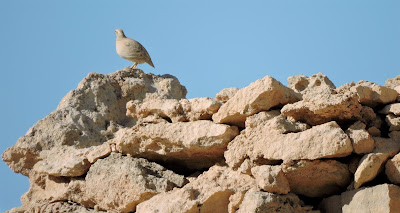This time I also decided to stop off at Mudhai oasis en route as well. This turned out to be very fortuitous.
Instead of spending all my time next to the watering hole which has a strong attraction to most birders, I wandered round the village itself for at least half of my time.
There are plenty of trees, bushes and spilt animal feed there which also attract birds.
Next to one set of bushes was a big find. I came across a Cretzschmar's bunting.
Cretzschmar's bunting
Cretzschmar's bunting 2
This female bird was very confiding and was eating non-stop. I got within 2.5 metres of it.
Cretzschmar's bunting 3
There is very little to beat the thrill of finding your own vagrant. The only downside is having to fill in another rarity report for the Rare Birds Committee.
Cretzschmar's bunting 4
Identification in the field of female birds is not quite as straightforward as for males. However the pure white eye ring, the big difference in the shades of the upper and lower mandible, the warmer upper tail colour, the orangey-rust throat were some of the features that all point to Cretzschmar's bunting rather than Ortolan bunting.
Furthermore, Ortolan bunting mostly migrate through Oman in April.
This was not the only highlight in Mudhai. I saw more African collared dove here than even at Mazyunah.
African collared dove
In total I observed 16. However 14 were roosting on a wire at the very entrance to the village from the Thumrait end. They were sharing the wire with three rock dove but no Eurasian collared dove.
four African collared dove
In the village in a bush at the edge of the main school, I found a small tree with eight Eurasian collared dove. The two species clearly don't roost together in this village. I suspect the only reason they do in Mazyunah is lack of alternatives.
nine African collared dove
It appears the African collared dove spend most time in the day near the camel pens on the left hand side as the Thumrait road comes into the village while the Eurasian collared dove are more likely to be inside the village and near the watering hole. Since most birders head to the latter two spots could be the reason they can miss them altogether.
I was lucky to be there so early I found them before they dispersed.
hooded wheatear 1"
hooded wheatear 2
Very close to the site of the Cretschmar's bunting was a male hooded wheatear on a wire.
I did also visit the area around the watering hole and I did get to see plenty of Nile Valley sunbird and palestine sunbird which are part of the attraction for this part of the village. However my pictures are better from a different site and so I will include them in that blog (the next one).
The one disappointment of this site was my failure to see any hypocolius this time. Mudhai normally houses a dozen or so each winter around the watering hole.
sand partridge
blackstart
Mudhai does have some more "ordinary" birds too. There are sizeable populations of blackstart, laughing dove, white-spectacled bulbul, desert lark and house sparrow.
After Mudhai I continued north west towards Mazyunah but stopping off at a new place for me called Tudho. I will blog about that next.












No comments:
Post a Comment